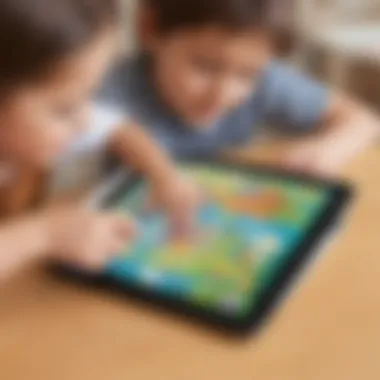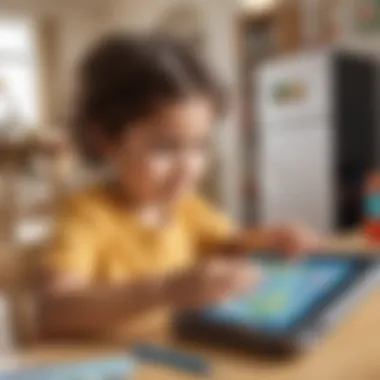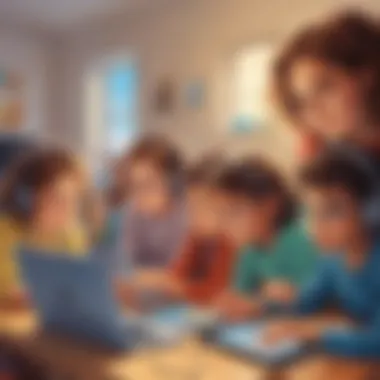Learning Devices for 4-Year-Olds: A Guide to Choices


Intro
The early years of a child's life form a crucial period for cognitive and social development. Learning devices play a significant role in enhancing education at this age. Given today's pervasive technology, the choices in educational tools are numerous. Effectively integrating learning devices for 4-year-olds requires understanding their educational benefits, the types of devices available, and how best to use them. Here, we explore the options—offering a coherent guide for parents and educators in selecting technology that nurtures a child's growth.
Creative Activities
Engaging 4-year-olds in creative activities serves as a fundamental means to learn. Crafts and hands-on projects vastly contribute to emotional and cognitive development.
Craft Ideas
Crafting ideas suitable for this age group often incorporate simple materials. Everyday items can be transformed into learning tools. Examples of these are:
- Construction paper cutouts
- Recycled bottles or boxes
- Non-toxic paints and markers
Step-by-Step Guides
For desired craft projects, clear, step-by-step guides are important. Here is a simple guide for creating a colorful paper collage:
- Gather materials like colored papers, scissors, and glue.
- Allow the child to tear or cut pieces from the colored paper.
- Let them create their design on a blank sheet.
- Help them glue their torn paper onto the blank sheet, and let it dry.
- Discuss the colors and shapes used in the collage.
Educational Value
Not only do creative activities stimulate imagination, but they also improve fine motor skills. Tasks such as cutting and gluing increase dexterity. Furthermore, conversation during craft time fosters language skills.
Fun Quizzes
The use of quizzes allows for both visual and interactive learning. Tailoring quizzes to young learners can significantly enhance their educational experience.
Quiz Topics
On platforms like ElemFun, various topics are covered to engage children effectively. Possible quiz themes include:
- Animals and their habitats
- Basic math concepts
- Shape recognition
Question Types
To engage children, a variety of question types is essential. This can range from multiple-choice questions to picture-based identification tasks. Such diversity maintains interest and challenges their knowledge on different levels.
Knowledge Reinforcement
Quizzes serve the purpose of knowledge reinforcement. After completing a quiz, children review concepts learned. Such repetition can aid retention and encourage exploration of new ideas.
Fact-Based Articles
Defining knowledge through reading is substantial. Fact-based articles targeting early learners provide foundational information on multiple topics.
Topics
An extensive range of subjects can be found, from animals to the environment, and even space exploration. These introductory concepts pave the way for future learning.
Engaging Content
Effective fact-based articles present information in accessible language. Using short paragraphs and bullet points can help in maintaining the child's attention span.
Understanding Early Learning Needs
Understanding the early learning needs of children is essential for shaping their educational experiences and outcomes. For parents and educators, recognizing these needs can lead to a more effective approach in selecting appropriate learning devices. A child's engagement with educational materials at the age of four often sets the foundation for future learning.
Effective learning devices not only entertain but also promote critical skills in cognitive and social development. They encourage curiosity, communication, and creativity in young learners. When selecting a learning device, considerations such as age appropriateness, user-friendliness, and educational content are paramount. This understanding can enrich the child's early experiences and make learning enjoyable and impactful.
The Cognitive Development of 4-Year-Olds
At four years old, children undergo significant cognitive development. This stage is characterized by rapid growth in language skills, memory, and problem-solving. They express the desire to learn about their environment. Learners quantify objects, classify items, and even begin to understand cause-and-effect relationships. During this vital period, brand new neural connections form, influencing how children think and process information.
Access to effective learning devices can cater to various cognitive skills. For instance, devices that offer interactive storytelling or problem-solving games engage and challenge a child's thinking abilities. Educational apps focus on language comprehension or logical reasoning. It is important to choose resources that meet developmental milestones.


The Role of Play in Learning
Play is a fundamental component of childhood education. During play, children explore new ideas and relate them to their experiences. Engaging in unstructured play can foster creativity and social cooperation. Research shows that learning devices can integrate play into educational experiences. For example, interactive games that ask children to cooperate or face challenges together can build teamwork skills.
Furthermore, play helps alleviate anxiety about new concepts. Learning devices that make use of game mechanics offer feedback and rewards. This positive reinforcement can increase a child’s confidence, which is vital for effective learning. Encouraging playful discovery can result in deeper knowledge retention. Parents should ensure that play remains a balance with learning, preventing overwhelm.
“The balance of play and structured learning forms a cohesive learning environment, optimizing a child's developmental potential.”
What Are Learning Devices?
Understanding what learning devices encompass is crucial for effectively guiding young learners. Learning devices serve as tools designed to augment the educational experience of children at an early age. They are particularly relevant considering that today’s education often integrates digital methods alongside traditional pedagogies. Utilizing these devices can stimulate various cognitive skills in young children, enhancing areas such as critical thinking, problem-solving, and creativity.
These tools become increasingly important when we consider their accessibility and popularity. Parents and educators are often faced with numerous options. Thus, it is vital to define and categorizing these devices to select appropriate methods that foster appropriate learning outcomes for their children.
Defining Learning Devices for Children
Learning devices for children encompass a diverse range of technologies and tools. These include items expressly intended for educational use such as tablets, educational applications, interactive toys, and smart games. The goal is not merely entertainment; the focus lies on enriching a child's exploration and understanding of concepts. Designed for hands-on interaction, these devices often lie at the intersection of education and play. It is essential to recognize that each device type comes with advantages and possible downsides.
Types of Learning Devices Available
Several substantive options exist when we assess learning devices for 4-year-olds. Each type highlights unique features that contribute differently to the learning process.
Tablets
Tablets serve as versatile learning platforms. They can host a wide array of educational apps and games tailored for young learners. The significant aspect of tablets is their portability. Children can engage with them almost anywhere, enabling a learning experience that is flexible and adaptable.
A key characteristic of tablets is their touch-screen interface. This interface supports interaction in a way that resembles natural learning, with pinching and swiping among features. However, a potential disadvantage is the reliance on screen time, which necessitates ongoing discussions about appropriate usage limits. Tablets can provide access to an expansive library of educational content through downloads or streaming, fostering personalized learning tailored to each child's interests.
Educational Apps
Educational apps are highly topical in current discussions about learning devices. They are designed to make learning more engaging through interactive games that can teach fundamental concepts. The key characteristic of educational apps is that they often aim to align their content with developmental objectives. This consideration positions them as beneficial avenues for reinforcing literacy and numeracy skills.
A unique aspect of educational apps is adaptive learning, where the application can adjust its difficulty based on user performance. This responsiveness is a strong point, as it can keep learning challenging yet attainable for children. On the downside, the overwhelming number of options can confuse parents when choosing applications that truly foster quality learning outcomes.
Interactive Learning Toys
Interactive learning toys combine traditional play with educational content. They can help in promoting physical activity alongside cognitive engagement. Such toys usually involve hands-on activity, which is crucial at this developmental stage. The distinguishing feature of these toys is their interactive nature; they often involve voice feedback, lights, or engaging sounds, which can captivate the attention of young minds.
However, some may argue that while these toys can provide a base level of engagement, effectiveness can vary greatly based on how children utilize them. Not all might foster deep learning, making parental guidance critical to ensure these toys work towards achieving desired educational milestones.
Smart Educational Games
Smart educational games represent a chapter where technology meets play-based learning. These are usually digital games incorporated within physical devices, which can result in a more comprehensively engaging educational experience. They stand out due to their often-versatile content that can unify various educational disciplines—mathematics, language skills, and more—into immersive play settings.
Furthermore, many smart games involve features such as instant feedback and progression metrics, thus providing insights into a child's learning pathway. However, a significant consideration must be player engagement levels; excessive reliance on smart games may limit interaction in cooperative or imaginative play.
In summary, understanding the variety and specific traits of learning devices aids in making informed choices about their implementation into learning paradigms. Utilizing the best tools that align with educational objectives extends a platform for more profound child development.
Key Features of Effective Learning Devices
Selecting learning devices for four-year-olds requires a solid understanding of what makes these tools effective. Key features play a vital role in ensuring that the device contributes positively to a child's learning experience. Understanding user-friendliness, content quality, educational value, safety, and durability will help parents and educators make informed choices. The aim here is to highlight these aspects clearly.
User-Friendliness and Interface Design
User-friendliness is essential in creating a positive learning experience. For children aged four, the interface must be simple and intuitive. Features like touch screens should be responsive. Buttons need to be large enough for small fingers. Ideally, children should navigate the device without adult assistance.
Application design matters significantly. Colourful icons and visual cues can guide young learners effectively. An adaptive interface that caters to varying skill levels further enhances usability. Limiting complicated features will help keep kids focused on educational activities.
Investing in a user-friendly device improves engagement and overall learning outcomes. When children can explore independently, their curiosity and problem-solving skills become more pronounced.
Content Quality and Educational Value
The educational quality of content is crucial as it determines the effectiveness of the learning device. Quality content offers a blend of educational depth and enjoyment. Games, exercises, and videos should align with developmental milestones. Moreover, they must promote various skills, such as literacy, numeracy, and critical thinking.
Devices with specific genres—for example, STEM topics—become advantageous as they encourage exploration of important subjects. Regular updates also keep the content relevant and engaging. The learning device should offer varied approaches to understanding different concepts.


Parents should prioritize devices with clear educational goals and measurable outcomes. With proper content, children can build a robust foundation for their future education.
Safety and Durability Considerations
When it comes to young children, safety remains a top priority. Learning devices should be safe to use, both in terms of physical design and digital content. The device edges should be rounded, minimizing risk of injury during accidental falls. Materials should be non-toxic, lightweight, and damage-resistant to withstand daily wear-and-tear.
It is also important to consider digital safety. Content should be appropriate and free of harmful elements such as violence or explicit language. Setting usage limits can protect against excessive screen time. Using settings that restrict access to potentially unsafe content is recommended.
In summary, prioritizing durability ensures that the investment lasts longer. With careful selection, children can benefit from a safe and effective learning environment that fosters development over time.
Regular attention to these key features will help guide parents and educators towards making the best choices when selecting learning devices for four-year-olds.
Integrating Learning Devices into Daily Routines
Integrating learning devices into daily routines is crucial for optimizing their benefits for young children. While technology can offer significant learning opportunities, its implementation must align with existing activities and schedules. Parents and caregivers should focus on establishing a balance between device usage and other important aspects of development such as physical play, socializing, and creative expression.
Balanced Usage of Technology
Achieving balanced usage of technology is essential to maximize learning outcomes. Young children should engage with educational devices in moderation to prevent overstimulation. A thoughtful balance offers several advantages:
- Encourages multifaceted learning: When blended with other activities, technology can reinforce skills through different modes of engagement.
- Mitigates the risk of dependency: Establishing parameters around technology use fosters healthy habits and control over screen time.
- Enhanced family interaction: Having set times for device usage can allow family members to engage in shared learning experiences.
It is advisable for parents to monitor usage time and benefits. Comparisons with traditional learning methods may reveal that devices supplement hands-on activities effectively if managed correctly. Tools like timers or scheduled sessions can help ensure learning remains productive. Information from organizations such as the American Academy of Pediatrics may provide additional guidance on appropriate screen time for children.
Creating Structured Learning Sessions
Creating structured learning sessions is another key component of successfully integrating learning devices. These sessions should be organized and purposeful, aimed at maximizing educational value. Here are some strategies for parents to consider:
- Set specific goals for each session: Having predefined learning objectives can help maintain focus and leverage engagement.
- Incorporate interactive and varied content: Use a combination of apps, videos, and games that vary in style to cater to different interests and learning paces.
- Introduce regular breaks: Short breaks within sessions can aid retention and concentration. This allows children to process information better without burnout.
Evaluating progress during structured learning can also provide insight into areas needing reinforcement. Frequent assessment allows parents to adjust the learning agenda based on individual needs.
Effective integration of technology into learning routines not only fosters academic development, but also nurtures social skills and creative thinking, important for a child's growth.
Overall, the careful incorporation of learning devices into daily routines enhances educational experiences, ensuring they are both engaging and fruitful.
Evaluating Learning Devices for 4-Year-Olds
Evaluating learning devices for young children is critical. It helps ensure that these tools support cognitive growth, creativity, and skill development. Not all devices are created equal, and knowing what works can benefit both the child and the caregiver. With the right information, parents can make informed choices that better fit their child’s unique learning style and needs.
Despite the many options available, selecting the preferred device requires deeper insights. Some factors should be prominently considered, as described below.
Reviewing Popular Devices in the Market
Comparison of Learning Tablets
When comparing learning tablets, one must examine their usability, app selections, and compatibility with modern educational standards. A key characteristic of learning tablets is their educational focus. For instance, devices like Kurio Tablet or Amazon Fire Kids Edition stand out due to their robust app ecosystems tailored for four-year-olds.
These tablets come equipped with various age-appropriate educational tools. They provide an intuitive interface allowing easy navigation for young users.
However, a consideration lies in the price range. Some tablets can be resource heavy, leading into financial deliberations. So, just because they have all the features listed does not instantly provide real educational value.
Assessment of Educational Apps
Educational apps play a significant role in shaping the learning experience of young children. Diverse apps target basic norms and foundational skills, playing into the cognitive development stage of 4-year-olds. Notably, apps like Endless Alphabet or Starfall present topical and engaging scenes, ensuring the child remains captivated.
Their gamified structure helps boost interest while enhancing vocabulary and basic knowledge. Apps can often feature feedback mechanisms, which adapt the content according to child responses. This adaptability is attractive to parent and educator alike.
Nevertheless, it is important to scrutinize the app’s effectiveness and avoid distractions presented by ineffectively designed games. New apps can saturate the market quickly but don’t always align with learning goals.
Analysis of Interactive Learning Toys
Interactive learning toys integrate physical engagement with educational content. Widely regarded options such as LeapFrog’s LeapReader or Fisher Price's Think & Learn line introduce content through visually stimulating interfaces. Children gain hands-on opportunities to learn in hybrid environments that transition easily from digital learning towards traditional methods.
The unique feature that benefits interactive toys involves multisensorial engagement; they include auditory feedback, movement, and visual stimuli making learning immersive.


Despite the advantages of blending physical play with educated content, some toys lack durability or require periodic battery replacements. Parents must weigh physical engagement against the likelihood of several repairs and operational costs.
User Feedback and Testimonials
Collecting user feedback holds a prominent place in evaluating any devices. Reviews provided by specific customers and experts highlight effectiveness, safety concerns, and user experiences that influence the purchasing decision. Testimonials can offer vivid insights into a device’s longevity and actual engagement levels. Potential issues are mitigated through reading shared insights before making selections, ensuring that the final choice caters adequately to the young learner’s needs.
The informed evaluation of learning devices can lead to enhanced educational experiences, compatibility with daily routines, and strategic choices tailored for child development. Remember, decisions should ultimately serve the growth of the child.
Potential Challenges and Solutions
Navigating the academic realm for four-year-olds is inherently complex. The influx of learning devices distinctly enhances the educational experience, yet it comes with notable challenges. Understanding these potential obstacles and their solutions is integral for parents and educators alike. The young minds at this critical development stage not only require educational support but also significant guidance through the intricacies of technology usage.
Screen Time Management
Managing screen time for young children presents itself as a salient issue. The risks associated with excessive screen exposure are well-documented, including impacts on attention spans and sleep patterns. Therefore, careful regulation is necessary to ensure the benefits of learning devices outweigh the drawbacks. Setting daily and weekly limits provides a practical framework for usage, balancing rewarding educational time and preventing overstimulation.
Parents can implement strategies such as using timers to remind children when their allocated time is nearing its end. Additionally, creating a schedule that intersperses learning device use with other activities ensures a more holistic approach to education. Trying to link device use with specific goals can also be beneficial. For example, if a child learns a concept via a gadget, engaging in physical play or hands-on activities to apply that learning can reinforce knowledge while promoting physical movement. Ultimately, the purpose is to support healthy screen habits for long-term cognitive and physical development.
Encouraging Offline Play
While the benefits of technology in education are significant, encouraging offline play is equally crucial. Interactive play nurtures creativity, problem-solving skills, and socialization, all of which are fundamental to early development. Furthermore, offline play can often provide substantial and diverse types of learning experiences that digital mediums simply cannot replicate.
Fostering a mix of learning opportunities requires a dedicated effort. It is essential to provide children with diverse, unstructured play options, such as building blocks, books, or art supplies. Encourage group activities that promote teamwork and cooperation with peers. Parcially removing gadgets during these sessions sends clear messages to children about the value of face-to-face interactions.
Taking proactive steps in both managing screen time and encouraging offline activities aligns with an overall goal to cultivate a well-rounded, early educational experience. Both parents and educators play a pivotal role in this journey.
Future Trends in Learning Devices for Young Learners
The evolution of learning devices is a vital component in shaping educational experiences for children. Understanding future trends allows parents and educators to make informed decisions. The focus here is on the emerging technologies due to their direct influence on how children learn and experience their education. These advancements offer new opportunities for cognitive growth and engagement.
Emerging Technologies in Education
Artificial Intelligence in Learning
Artificial intelligence is becoming a major influence in educational devices. Its ability to adapt to individual children's needs distinguishes it as a strong choice. One key characteristic is personalized learning experiences. AI can analyze a child's responses and performance, adjusting lessons accordingly. This responsiveness makes the learning more effective.
A unique feature of artificial intelligence in learning devices is its data tracking capability. It allows parents to monitor progress over time. The advantage of this is that parents can easily identify areas where the child excels or struggles. The disadvantage, however, can include privacy concerns. Data safety is something to verify with any learning device that utilizes AI technology.
Augmented Reality Applications
Augmented reality is also making waves in educational technology. It enhances the learning experience by blending the digital and real worlds. Its key characteristic is the interactive elements it adds to traditional learning practices. In the context of early learning, this can visualize learning in a more absorbing way.
One unique aspect of augmented reality applications is their ability to provide immersive experiences. Children can interact with 3D models, which can bring concepts to life. The advantages of this technology include increased engagement and understanding. However, it requires quality devices and apps to function optimally, which can impose additional costs.
The Impact of Virtual Reality on Early Education
Virtual Reality (VR) technology is another trend worthy of discussion. VR can create entire classrooms in virtual spaces, allowing immersive learning environments. This potentially benefits young learners significantly. Children may experience simulations that enhance their understanding of various subjects.
However, the impact of VR extends beyond mere academics. It offers emotional and social learning experiences. The immersive environment can support empathy development by placing children in various perspectives. This format challenges them to understand emotions and situations differently.
In summary, as learning devices house these advanced technologies, their quality and breadth will continue to improve. Keeping up with these trends is essential for providing children with the best possible educational tools, fostering cognitive and intuitive growth.
The future presentations of learning devices will significantly alter how young learners engage with educational content. Staying informed about these evolving technologies will positively affect both children's learning experiences and outcomes.
The End and Recommendations
The conclusion and recommendations section of this article synthesizes the insights provided throughout. Focusing on key points is vital. This discussion helps parents and educators reflect on the presented material and apply it effectively. The world of learning devices for four-year-olds is expansive. As children grow, the right tools can support both cognitive advancement and social skills.
Choosing the Right Device for Your Child
Choosing an appropriate learning device for your child is a crucial decision. Parents should consider several factors to guide their choice.
- Educational Purpose: Understand what you want your child to learn. Is the goal mathematics, reading comprehension, or perhaps developing fine motor skills? Selecting a device that aligns with educational goals increases its potential impact on your child’s learning experience.
- Age Appropriateness: Always check the recommended age for specific devices. An overly complex tool may confuse a child, while simpler devices may not challenge them enough.
- Entertainment Value vs. Educational Content: While engagement is necessary, it is important not to prioritize fun alone. Evaluate the balance between entertainment and educational quality in apps and games. Engagement can keep a child interested, but learning is the end goal.
- Durability and Longevity: Young ones can be rough on devices. Thus, look for products known for their toughness. Tablets or toys made for toddlers often withstand drops and spills better.
- Screen Time and Balance: Establish clear boundaries for device usage. Consider how the selected device fits with other activities like playtime and family interactions. Aim for a balance that favors overall development.
By reflecting on these areas, parents can make informed choices for their child's learning journey, ultimately selecting devices that will have positive outcomes.
Encouraging Parental Involvement
Parental involvement plays a transformative role in maximizing the benefits of learning devices. Support from parents not only enhances the learning experience but also reinforces the child’s development. Here are strategies to involve parents:
- Active Participation: Engage with your child during their learning time. Ask about what they are learning and encourage them to express their thoughts. This not only develops their analytical skills but also shows them that you value education.
- Co-Exploration: Explore the device together. Play educational games or attempt challenges on apps as partners. Sharing experiences can strengthen bonds and make the learning session more meaningful.
- Setting Goals and Expectations: Co-create learning goals with your child. During your session, pass on expectations of the desired outcomes clearly. Establishing objectives can motivate them.
- Monitoring Usage: Keep an active watch on the device's use. Understanding what content draws your child’s attention helps you engage thoughtfully in discussions about what they encounter.
By prioritizing involvement, you cultivate a supportive environment where learning flourishes. Tools alone do not determine a child’s success; involvement from parents significantly contributes to effective learning approaches.







